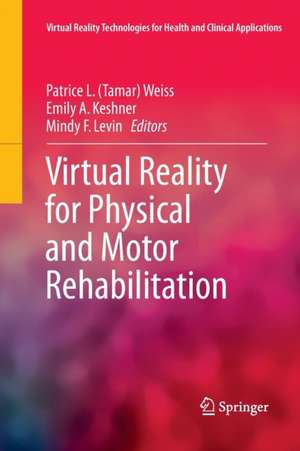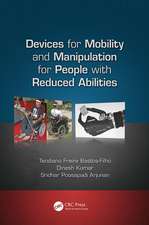Virtual Reality for Physical and Motor Rehabilitation: Virtual Reality Technologies for Health and Clinical Applications
Editat de Patrice L. (Tamar) Weiss, Emily A. Keshner, Mindy F. Levinen Limba Engleză Paperback – 3 sep 2016
Virtual Reality for Physical and Motor Rehabilitation reviews two decades of progress and anticipates advances to come. It offers current research on the capacity of VR to evaluate, address, and reduce motor skill limitations and the use of VR to support motor and sensorimotor function, from the most basic to the most sophisticated skill levels. Expert scientists and clinicians explain how the brain organizes motor behavior, relate therapeutic objectives to client goals and differentiate among VR platforms in engaging the production of movement and balance. On the practical side, contributors demonstrate that VR complements existing therapies across various conditions such as neurodegenerative diseases, traumatic brain injury and stroke. Included among the topics:
- Neuroplasticity and virtual reality.
- Vision and perception in virtual reality.
- Sensorimotor recalibration in virtual environments.
- Rehabilitative applications using VR for residual impairments following stroke.
- VR reveals mechanisms of balance and locomotor impairments.
- Applications of VR technologies for childhood disabilities.
| Toate formatele și edițiile | Preț | Express |
|---|---|---|
| Paperback (1) | 832.74 lei 6-8 săpt. | |
| Springer – 3 sep 2016 | 832.74 lei 6-8 săpt. | |
| Hardback (1) | 1035.18 lei 6-8 săpt. | |
| Springer – 24 iul 2014 | 1035.18 lei 6-8 săpt. |
Preț: 832.74 lei
Preț vechi: 876.57 lei
-5% Nou
Puncte Express: 1249
Preț estimativ în valută:
159.34€ • 166.37$ • 131.88£
159.34€ • 166.37$ • 131.88£
Carte tipărită la comandă
Livrare economică 04-18 aprilie
Preluare comenzi: 021 569.72.76
Specificații
ISBN-13: 9781493953141
ISBN-10: 1493953141
Pagini: 241
Ilustrații: IX, 232 p. 50 illus.
Dimensiuni: 155 x 235 x 13 mm
Greutate: 0.35 kg
Ediția:Softcover reprint of the original 1st ed. 2014
Editura: Springer
Colecția Springer
Seria Virtual Reality Technologies for Health and Clinical Applications
Locul publicării:New York, NY, United States
ISBN-10: 1493953141
Pagini: 241
Ilustrații: IX, 232 p. 50 illus.
Dimensiuni: 155 x 235 x 13 mm
Greutate: 0.35 kg
Ediția:Softcover reprint of the original 1st ed. 2014
Editura: Springer
Colecția Springer
Seria Virtual Reality Technologies for Health and Clinical Applications
Locul publicării:New York, NY, United States
Cuprins
Volume Introduction and Overview.- Neuroplasticity and Virtual Reality.- Motor Learning and Virtual Reality.- Vision, Perception and Object Manipulation in Virtual Environments.- Sensorimotor Recalibration in Virtual Environments.- Validity of virtual reality environments for sensorimotor rehabilitation.- Rehabilitation Applications using Virtual Reality for Persons with Residual Impairments following Stroke.- Virtual reality augmented training for improving walking and reducing fall risk in patients with neurodegenerative disease.- Virtual Reality Reveals Mechanisms of Balance and Locomotor Impairments.
Recenzii
From the book reviews:
“This comprehensive book adds virtual reality to the toolkit of technologies that support patients’ motor recovery and rehabilitation after a neurological or orthopedic injury. … The audience includes not only students, but also experienced physical and occupational therapists, rehabilitation neuroscientists, neurologists, and physical medicine rehabilitation physicians. … This is a well-conceived and well-organized book. It is a must for those involved in technology-enhanced recovery or rehabilitation work with patients.” (Deborah J. Gaebler-Spira, Doody’s Book Reviews, January, 2015)
“This comprehensive book adds virtual reality to the toolkit of technologies that support patients’ motor recovery and rehabilitation after a neurological or orthopedic injury. … The audience includes not only students, but also experienced physical and occupational therapists, rehabilitation neuroscientists, neurologists, and physical medicine rehabilitation physicians. … This is a well-conceived and well-organized book. It is a must for those involved in technology-enhanced recovery or rehabilitation work with patients.” (Deborah J. Gaebler-Spira, Doody’s Book Reviews, January, 2015)
Notă biografică
Patrice L. (Tamar) Weiss, Ph.D., is an occupational therapist with a M.Sc. degree in kinesiology and a Ph.D. degree in physiology and biomedical engineering. In 2001, she founded the Laboratory for Innovations in Rehabilitation Technology (LIRT) at the University of Haifa where she and her team develop and evaluate novel virtual environments, haptic interfaces and co-located technologies to explore the effect of individual and collaborative rehabilitation. Dr. Weiss’ responsibilities include supervision of all aspects related to technology development and implementation. She has authored more than 100 peer-reviewed journal articles.
Textul de pe ultima copertă
While virtual reality (VR) has influenced fields as varied as gaming, archaeology, and the visual arts, some of its most promising applications come from the health sector. Particularly encouraging are the many uses of VR in supporting the recovery of motor skills following accident or illness.
Virtual Reality for Physical and Motor Rehabilitation reviews two decades of progress and anticipates advances to come. It offers current research on the capacity of VR to evaluate, address, and reduce motor skill limitations, and the use of VR to support motor and sensorimotor function, from the most basic to the most sophisticated skill levels. Expert scientists and clinicians explain how the brain organizes motor behavior, relate therapeutic objectives to client goals, and differentiate among VR platforms in engaging the production of movement and balance. On the practical side, contributors demonstrate that VR complements existing therapies across various conditions such as neurodegenerative diseases, traumatic brain injury, and stroke. Included among the topics:
Virtual Reality for Physical and Motor Rehabilitation reviews two decades of progress and anticipates advances to come. It offers current research on the capacity of VR to evaluate, address, and reduce motor skill limitations, and the use of VR to support motor and sensorimotor function, from the most basic to the most sophisticated skill levels. Expert scientists and clinicians explain how the brain organizes motor behavior, relate therapeutic objectives to client goals, and differentiate among VR platforms in engaging the production of movement and balance. On the practical side, contributors demonstrate that VR complements existing therapies across various conditions such as neurodegenerative diseases, traumatic brain injury, and stroke. Included among the topics:
- Neuroplasticity and virtual reality.
- Vision and perception in virtual reality.
- Sensorimotor recalibration in virtual environments.
- Rehabilitative applications using VR for residual impairments following stroke.
- VR reveals mechanisms of balance and locomotor impairments.
- Applications of VR technologies for childhood disabilities.
Caracteristici
First comprehensive volume about VR applications for physical and motor rehabilitation Discusses VR applications for specific physical and motor disabilities such as stroke, TBI, Parkinson's, cerebral palsy, multiple sclerosis Identifies impact of VR on perceptual and motor processes Includes supplementary material: sn.pub/extras












